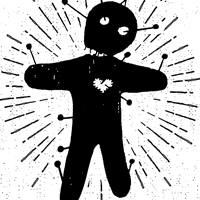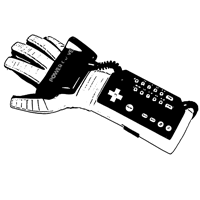I’d like to drill down on a couple of things in the investigation system I posted last week that have had a somewhat unintended effect: this campaign basically runs itself.
By that I mean that the players are specifically driving their own play most of the time, and are extremely happy to dither over day-to-day (sometimes hour-to-hour) activities. I only have to inject new planned content every few sessions to keep things lively, and otherwise my players seem perfectly pleased to spend most of their time on self-directed goals (mostly involving training, research, and improving their relationships with NPCs).
This engine has three major pieces, spelled out in more detail in last week’s post:
- Spending XP costs an action block per XP, so the players need to plan their training time against their available XP and which traits they want to improve (and when, if they need, say, to improve their magic casting stats before an upcoming event).
- New spells have become one of the major types of “loot,” and research rolls take up time blocks.
- Perhaps the biggest factor is the Persona 5-inspired NPC relationship system. Each NPC has a 10-step track of benefits gained by improving the PC’s relationship with them, and players must plan their hangouts and make sure to include NPCs in their investigation actions if they want to be able to allocate relationship points.
That last bullet has proven to be key. This obviously wouldn’t work in a game with a lot of travel, but for a city-based game it’s really interesting. There need to be a lot of interesting NPCs around that the players can choose to spend time with. As I mentioned in my long-ago Technoir review, the easiest way to get players to invest in an NPC relationship is to have them quantify it on their character sheets (so the NPC effectively just becomes another of their own statistics). Since I implemented this system, the players have been turbo-charged in wanting to get to know the various NPCs.
An important factor in this is to be able to generate a bunch of interesting NPCs. The trick I used for this was actually pretty simple: I semi-randomly combined skills, qualities, and drawbacks from the system in a spreadsheet, then used that as a seed for the NPC. Each NPC is essentially the exemplar of three or four traits. For skills, that means that the NPC has it at a very high rank. For qualities and drawbacks, they’re either the only known NPC with that trait, or they have it at the highest rating.
For example, I wound up with one NPC that was really good at Science, had the Superscience quality, but had Depression. It was a short walk to Darwin, the senior class’ physics genius.
Since Buffy comes with plenty of each type of trait, I was able to generate 24 students and a similar number of adults (the adults have two signature skills, and reuse the pool of qualities and drawbacks from the students). That’s a lot of seeds for content generation.
It also proved useful in coming up with a ten-step relationship progression. Since three of the steps are pre-defined (Acquaintance, Friend, and BFF) and one or two are Good Example (with their signature skill or skills), I only had to come up with five or six unique relationship rewards for each character.
Playing on Roll20 helps with all of this. I’m able to just make all of this information public on the NPC’s journal entry, so players can see what every NPC they know is basically about and what they’ll get be becoming better friends with them. It might be harder face-to-face.
Also, I make the players keep personal track of their progress toward each new rank of an NPC (and on their XP spends, incidentally). I only update NPCs when the player moves up a rank and tells me (moving their name next to the new relationship rank). This reduces my bookkeeping to a manageable amount.
Below are several example NPCs.
Angelina Pierce Yearbook Photographer
Signature Skill, Quality, Drawback: Wild Card (Animal Handling), Artist, Misfit
A girl with a lot of interests, but not a lot of luck talking to people, Angelina seems happiest when hiding behind a camera or working with animals. It’s dealing directly with people that gives her problems. She’s the main yearbook photographer for Eastbend High and works part time at the Pet Resorts and Vet with Agnes. Danny knows she’s clued-in to the supernatural, having seen some of her photos of vampires using a telephoto lens that she tried to pass off as art photos.
Everyone has discovered that Agnes is a werewolf. She locks herself in a cage she got from the vet’s office on full moons.
Relationships (Temperance)
- Acquaintance (Anthony, Danny)
- Angelina will tag along to photographically document dangerous or strange situations
- Friend (Agnes)
- Animal Magnetism: Animals won’t attack you unless ordered or supernaturally manipulated
- Good Example: Animal Handling
- Crying Wolf: You gain a +2 modifier to Influence rolls to convince people they’re in danger
- Candid Camera: Spend a Drama Point to retroactively declare that Angelina was hiding and taking pictures of a scene you were in where that would be reasonable
- BFF
- Counter surveillance: You have learned to hide your features so it’s nearly impossible to get pictures/video proving you were doing something
- Wolf Whisperer: You can verbally control Angelina while she is transformed into a werewolf
Darwin Jackson Physics Genius
Signature Skill, Quality, Drawback: Science, Sorcery (Superscientist), Emotional Problems (Depression)
Darwin’s parents have a love of science that they imparted to their boy, though he wound up favoring the hard sciences rather than biology, which is a bit of an embarrassment since his dad is the high school bio teacher, Cody Jackson. But he’s a genius at physics, and there are rumors that he’s built some gadgets that might get him into MIT on a scholarship, if the Army doesn’t notice first and snap him up for DARPA.
In the meantime, science doesn’t pay the bills or instill a work ethic, so he has a part time job at Gold’s Gym.
Relationships (The Hermit)
- Acquaintance (Pete)
- Darwin may cut you in on his projects, allowing you to learn Superscience
- Friend
- Newtonian Physics: +2 modifier when making trick shot attacks
- Good Example: Science (Anthony)
- Astrophysics: +4 modifier on investigation rolls where celestial events are involved
- Research Encouragement: Darwin gains +1 Superscience for each PC at this level
- BFF
- Just the Thing: Darwin will often provide you a Superscience gadget that’s surprisingly helpful in the current crisis
- Job Connections: Darwin gets a job somewhere high-tech and can provide you access
Dienarr Prins Siobhan’s Girl Friday
Signature Skill, Quality, Drawback: Driving, Good Luck, Mental Problems (Reckless)
Dienarr’s family is Dutch, and owns High Street Clothing. She doesn’t have much of an accent, the Prinses have been here so long. Other than her work for the family business and her bizarre devotion to Siobhan Faobhar, her great love is driving. Her family got her a sporty purple coupe for her 16th birthday, and it’s only through her insanely good luck that she hasn’t wrapped it around a phone pole or killed someone yet, the way she drives.
She’s not super bright, but she’s pretty well off and lucky so that accounts for a lot.
Relationships (Wheel of Fortune)
- Acquaintance (Anthony, Danny)
- Dienarr will drive you around, if it’s not too much trouble
- Friend
- Lucky Charm: You can ignore your bad luck, Pete, or act as if you have a 1 point Good Luck
- Good Example: Driving
- Halvsies!: Dienarr will pay for half of a major purchase if she expects to get to use it a fair amount
- Cab Service: Dienarr will drop most things to pick you up and drive you across town (Pete)
- BFF
- The Zen of Recklessness: Dangerously risky actions you take have a +1 modifier to succeed
- Charmed Life: Dienarr gains an additional +2 Good Luck for each PC at this level
Eve Doyle Scary Girl
Signature Skill, Quality, Drawback: Wild Card (Demolitions), Jock, Mental Problems (Delusions)
Pete’s friend Eve is trouble. One of the town’s many military brats, her father does something with ordinance and she’s learned way too much about it. She got dragooned onto the track team last year after training herself to run away from fuses she’d lit. She’s medicated for schizophrenia, but sometimes forgets to take a dose and that’s a bad weekend if she has some thermite mixed up. Most of the time she knows to ignore the voices telling her to blow things up.
If she’s not in school (which is more often than most teenagers aren’t in school), she can often be found at Sid’s Junkyard, making pipe bombs.
Danny, Pete, and Agnes have some sway with Mrs. Doyle regarding informing her when Eve is off her meds.
Relationships (The Tower)
- Acquaintance (Shannon)
- Eve will provide you small amounts of minor explosives/incendiaries (Anthony, Danny)
- Friend (Agnes)
- Eve will help you on demolitions crafting, doubling your output
- Good Example: Demolitions
- Eve will provide you small amounts of the kind of things that would get you on a watchlist (Pete)
- Don’t blow your hand off: +3 modifier to avoid damage from explosions/fire
- BFF
- Outrun the Explosion: Increase your running speed by +2 in dangerous situations
- The Voices are Real: Eve gains a spirit-related power for each PC at this level
Jamarion Barrera Latin Club President
Signature Skill, Quality, Drawback: Languages, Photographic Memory, Covetous (Lecherous)
Jamarion “Jams” Barrera has mastered all the languages taught at the high school. He was already fluent in Spanish when he got there, and his excellent memory made it easy for him to pick up Latin and French. He’s looking for something new and interesting to pick up.
The kid is really hard up for sex. It’s likely that he only worked so hard to be president of the Latin club since that means more time around Ms. Houghton. That doesn’t stop him from taking a shot at asking out most of the other girls at school, though. At least he tends to let it go once shot down.
He works part time as a stock boy at Rose’s department store.
Relationships (The Lovers)
- Acquaintance (Agnes, Anthony)
- Jams will help you with translation research (Danny)
- Friend
- Jams will let you use his employee discount at Rose’s
- Good Example: Languages
- Modern Cyrano: You gain a +2 modifier on Influence rolls to Woo
- Memory Training: +1 modifier to investigation rolls when remembering details would be useful
- BFF
- Cultural Immersion: You understand the gist of foreign languages, even if you don’t speak them
- Quick Occult Study: Jams gains +2 Occultism for each PC at this level
Oliver Brown Most Likely to Do Hard Time
Signature Skill, Quality, Drawback: Crime, Resistance, Bad Luck
Clearly just waiting until he gets kicked out of school to really ramp up his criminal enterprises, Oliver is always hustling. He’s the guy you go to if you want to buy something that “fell off a truck,” though he doesn’t really seem to have the hookup for drugs. Maybe it’s just that he knows his own bad luck and reputation, so it’s not worth the risk for him to be holding. He can be found lurking around the old mill warehouses when he’s not in school.
Relationships (The Hanged Man)
- Acquaintance (Agnes, Pete)
- Oliver will sell you his illicit goods (Shannon)
- Friend
- Oliver will alert you of upcoming criminal enterprises, and serves as a criminal Contact (Anthony)
- Good Example: Crime
- Oliver will sell you his illicit goods at a 20% discount
- You can send Oliver to do a minor crime for you on his own time
- BFF
- Business Partner: You make $100 a week in illicit income
- Phantom Thief: Oliver gains +1 “Sorcery” for each PC at this level, useful for spell-like abilities that let him “steal” supernatural items and features
Siobhan Faobhar Local Colonel’s Daughter
Signature Skill, Quality, Drawback: Gun Fu, Attractiveness, Mental Problems (Cruelty)
Daughter of the commander of Fort Blake, Siobhan pronounces her last name like “Fire” and is considered both extremely cool and unbearably hot by most of the student body at Eastbend High. She does target shooting competitively, and would be training for international competitions if she wasn’t set on going into ROTC and then into the military when she graduates (Eastbend High isn’t big enough for JROTC).
Most of the school misfits are sad that she’s so pretty, talented, and undeniably badass, because she’s also a sadist that uses her influence against those that are safe targets for her. Like, those she’s picked on are honestly afraid that she might shoot them if they were alone in the woods and she thought she could get away with it. Cognizant of her reputation even if she is a sociopath, she limits her bullying at school to social torments.
Strangely, she doesn’t date. Anyone who’s asked her gets brushed off as neither attractive nor awesome enough to date her.
When she’s not at school, she can often be found at the Espresso Pump holding mean girl court.
Relationships (Strength)
- Acquaintance (Shannon, Anthony, Pete)
- Siobhan will try to avoid being mean to you at school
- Friend/Frenemy
- Siobhan will show up to shoot things for you if it’s convenient (Agnes)
- Good Example: Gun Fu
- Siobhan will use her military connections to help you
- Angel of Death: Spend two Drama Points to have Siobhan show up, guns blazing, if you’re in trouble (Danny)
- BFF/Best Frenemy
- Siobhan will “borrow” military-spec hardware for you
- High Functioning: Siobhan will become literally like 20% less terrible for each PC at this level
Zara Wright Out and Proud Witch
Signature Skill, Quality, Drawback: Occultism, Occult Library, Humorless
Danny’s friend Zara is about what you’d expect from a small, slightly-gothy Wiccan girl in a small southern town: totally serious about her faith and ready to fight you about it. While she’s never been very good in a brawl, at some point a lot of the school bullies became convinced that she could “get” them (possibly with some kind of curse), and started leaving her alone.
She works at Party Town for the discount on Halloween props.
She lives in one of the smaller little communities up the interstate that doesn’t have its own high school. Thus, she did not meet everyone until freshman year, when she got bussed in (having attended elementary and middle school at her home town).
Relationships (High Priestess)
- Acquaintance (Anthony)
- You can use Zara’s +2 Library and she’ll assist with research
- Friend
- Zara will provide ritual casting assistance (Pete)
- Good Example: Occult
- Zara will research spells for you on her own time
- Warding Buddy: You benefit from a +1 Will of the Coven at all times (Agnes, Danny)
- BFF
- Ingredients Shopper: Zara can provide a free Rare casting component 1/week
- Witch awakening: Zara gains +1 Sorcery for each PC at this level
Casey Harris High School Principal
Signature Skills; Quality; Drawback: Getting Medieval, Science; Photographic Memory; Bad Luck
A former science teacher and nationally ranked fencer, it’s unclear how Casey Harris wound up being principal of a large rural high school. It’s likely due to his well-known bad luck. Between being an actual decent educator, his impossibly good memory for student details, and his willingness to beat the living shit out of anyone that pushes him, he’s managed to gain a grudging respect from the student body.
Relationships (King of Swords)
- Acquaintance
- Getting called to the principal’s office is a lot less scary (Shannon)
- Friend
- Fencing Practice: Use a full relationship action with Harris AND allocate Getting Medieval XP
- Good Example: Getting Medieval
- Princi-Pal: Remove one free level of Delinquency (or Dereliction if you work for him) each week on Sunday
- Good Example: Science
- BFF
- The Good Equipment: Harris gifts you a very nice combat-ready rapier or saber
- Castling: If you get in a fight in the school, Harris shows up to assist
Alexander Jenkins Superstitious Boys’ Football Coach
Signature Skills; Quality; Drawback: Occultism, Sports; Occult Library; Covetous (Ambitious)
The Jenkins family owns and runs D’Antonio’s pizza, but Alexander was interested in teaching. With a special interest in the secret history of the world, he got a degree that let him teach social studies, but he was always good at sports so also wound up coaching the school’s football team.
Pete knows he’s clued-in to the supernatural, after some of the football team got into his special collection of occult reference books three years ago and wound up summoning some kind of entity to possess them. Mr. Jenkins was briefly caught up in the ambition of how supernaturally-empowered teens were finally having a winning season, and let it go on for far too long before they got dangerous and violent, forcing him to exorcise them and resulting in permanent damage that left them benched. But at least Pete got to start from his sophomore year on.
Mr. Jenkins has been a lot more careful about his occult collection and dabbling since then, but grudgingly allowed Pete and his friends to use it after Danny offered to share some of his family’s own tomes and a promise that they wouldn’t summon any demons.
Relationships (King of Rods)
- Acquaintance (Shannon)
- Jenkins will let you use his gym-based library (Agnes, Anthony, Danny)
- Friend (Pete)
- Jenkins will help you do spell research if it’s something that might be useful for football
- Good Example: Sports
- Blitz: Double teamwork bonuses when charging at the same target
- Good Example: Occultism
- BFF
- Sack: +2 modifier on Slam Tackle maneuvers.
- Wizard awakening: Jenkins gains +1 Sorcery for each PC at this level
Lucy Burns Wiccan High Priestess
Signature Skills; Quality; Drawback: Driving, Occultism; Sorcery; Mental Problems (Zealot: Wicca Pacifist)
Rumored to be the town’s Wiccan High Priestess (if that even means anything in a place that’s 99% some denomination of Christian), Lucy Burns is British and nobody is really sure why she’d go to school in such a small little town so far away from her home. She’s outspoken about her faith to those who are interested, and follows a particularly pacifistic praxis where she considers any kind of willful violence as an affront against the Goddess. She works at Daily Grind, the coffee shop, as a barista when she’s not in class.
Relationships
- Acquaintance
- You can go to the Wicca meetings (Agnes, Danny)
- Friend
- Lucy will help you do spell Research
- Good Example: Occultism
- Draw Down the Goddess: You have a 50% chance of immediately recovering a Drama Point spent to cast a white magic spell
- Good Example: Driving
- BFF
- That It Harm None: Starting each fight, you have a +5 bonus to defense rolls until you attack someone in combat.
- Protector: Automatically benefit from a powerful protective spell that Lucy casts for you on the regular
Dane Petty Auto Shop Repair Guy
Signature Skills; Quality; Drawback: Acrobatics, Mr. Fix-it; Hard to Kill; Werewolf
Dane Petty is the cousin of a pretty famous race car driver who just happened to be going to Riverview when the owner of Sid’s Auto Repair needed new help. Fortunately, Dane is good at fixing cars, having learned something working the pit crew as a teen. He’s also pretty fast, and can frequently be seen out training for some ultra-marathon or triathlon.
Relationships
- Acquaintance (Agnes, Anthony, Pete)
- Dane will let you fix stuff in the shop, no questions asked
- Friend (Danny)
- Dane will fix minor things for you in the shop without you taking the time
- Good Example: Mr. Fix-it
- Car Surfing: Halve penalties from maneuvers on moving objects
- Good Example: Acrobatics
- BFF
- Those Pettys: Gain access to NASCAR-grade racing parts and cars
- Wolf Whisperer: You can verbally control Dane while he is transformed into a werewolf
Molly George Getaway Driver and Smuggler
Signature Skills; Quality; Drawback: Crime, Driving; Fast Reaction Time; Talentless
Parents Clara and William run Sid’s Barbershop (Sid was Clara’s father). Works as a barber (too unartistic and annoyed to give anything but a basic trim). Fiery.
Relationships
- Acquaintance (Agnes, Anthony, Pete, Danny)
- Crime Taxi: You can pay Molly $50 an hour (min one hour) plus 5% to be your getaway driver
- Friend
- Molly will give you a free haircut (you get what you pay for)
- Good Example: Driving
- Ride Along: Use a full relationship action with her AND allocate Driving XP
- Good Example: Crime
- BFF
- Hell on Wheels: Spend a Drama Point when near a road to have Molly arrive in her car to cause a distraction or help you escape
- Muse: Molly loses the effects of Talentless for you (the haircuts are pretty good!)
Mia Thompson Antiques Store Owner
Signature Skills; Quality; Drawback: Art, Getting Medieval; Watcher; Love
Mia Thompson is a British woman who recently opened Thompson’s Treasures, the antique store. She seems to be a single mother, though some think that she might just be fostering or have adopted young Rona, and she looks pained and changes the subject if anyone brings up a husband. She’s extremely knowledgeable about all varieties of antique art.
Relationships
- Acquaintance (Agnes, Anthony, Danny, Shannon)
- Sword Art Online: Mia will use her museum and Watcher connections to order you basic monster-fighting weapons and gear with minimal markup. (Pete)
- Friend
- That Kind of Watcher: Mia will assist with Art-based Research rolls.
- Good Example: Getting Medieval
- The Cavalry: Spend a Drama Point to have Mia and Rona show up in town to assist in a difficult fight.
- Good Example: Art
- BFF
- And ALSO a Fighter: You have a 30% chance of regaining a Drama Point spent to protect someone you love with self-sacrifice or violence.
- Witch awakening: Mia gains +1 Sorcery for each PC at this level
 This spell only functions outdoors at night, drawing down a bolt of radiant moonlight that burns the target. It is particularly effective against vampires, forging moonlight into a brand almost as potent as the sun.
This spell only functions outdoors at night, drawing down a bolt of radiant moonlight that burns the target. It is particularly effective against vampires, forging moonlight into a brand almost as potent as the sun. This ritual beckons a vengeance demon to appear. The demon is not bound on arrival.
This ritual beckons a vengeance demon to appear. The demon is not bound on arrival. This spell empowers a jack o’ lantern to reveal and solidify spirits caught in its light. It is a form of the Solidify Spirit spell that can only be used on All Hallows Eve.
This spell empowers a jack o’ lantern to reveal and solidify spirits caught in its light. It is a form of the Solidify Spirit spell that can only be used on All Hallows Eve. This spell reveals if a subject is a werewolf or other kind of animal shapeshifter.
This spell reveals if a subject is a werewolf or other kind of animal shapeshifter. This spell protects the target from the bite of a lycanthrope or similar types of infectious monster bite. If cast on an infectious monster (including a lycanthrope in human form before transforming), it instead renders that target not infectious for the duration.
This spell protects the target from the bite of a lycanthrope or similar types of infectious monster bite. If cast on an infectious monster (including a lycanthrope in human form before transforming), it instead renders that target not infectious for the duration. This spell calms an animal or bestial monster, and may even put the target to sleep.
This spell calms an animal or bestial monster, and may even put the target to sleep. (This spell was haphazardly generated by Agnes, Danny, and Zara with help from Eve and Anthony. It started at 3 but will reduce in difficulty to 0 as the kinks are ironed out when cast as a full ritual, but remains 2 for quick-cast by a single caster.)
(This spell was haphazardly generated by Agnes, Danny, and Zara with help from Eve and Anthony. It started at 3 but will reduce in difficulty to 0 as the kinks are ironed out when cast as a full ritual, but remains 2 for quick-cast by a single caster.) This invocation of the goddess can only be used when the walls of reality are thin, and causes the casters to disappear and enter a dreamlike fugue where they inhabit the body of their worst enemy or someone they otherwise hate until the following midnight. The inhabited target cannot be magical, supernatural, or even completely aware of the supernatural or will shrug off the effect (forcing the caster into their next-biggest enemy). Otherwise, the possessed individual is still semi-conscious, will resist strong out of character actions, and may ultimately treat the whole thing as a strange dream or unusual psychiatric event.
This invocation of the goddess can only be used when the walls of reality are thin, and causes the casters to disappear and enter a dreamlike fugue where they inhabit the body of their worst enemy or someone they otherwise hate until the following midnight. The inhabited target cannot be magical, supernatural, or even completely aware of the supernatural or will shrug off the effect (forcing the caster into their next-biggest enemy). Otherwise, the possessed individual is still semi-conscious, will resist strong out of character actions, and may ultimately treat the whole thing as a strange dream or unusual psychiatric event. This spell was an old protective ritual, usually cast before delving into magics that affected the mind.
This spell was an old protective ritual, usually cast before delving into magics that affected the mind. This assemblage creates highly compact flammable chemicals packed around an electronic mechanism that can semi-miraculously control their ignition rate without melting until the object is fully consumed. It is intended, though the use of a synched radio controller, to make a specially-constructed forge burn hotter and better for the purposes of forging and smelting metals.
This assemblage creates highly compact flammable chemicals packed around an electronic mechanism that can semi-miraculously control their ignition rate without melting until the object is fully consumed. It is intended, though the use of a synched radio controller, to make a specially-constructed forge burn hotter and better for the purposes of forging and smelting metals. This assemblage causes a gauntlet to temporarily emit an electric field that interacts with the ethereal: to wit, you can punch ghosts.
This assemblage causes a gauntlet to temporarily emit an electric field that interacts with the ethereal: to wit, you can punch ghosts. This assemblage loads a maglite with etheric resonators to reveal and solidify “spirits” caught in its light. Due to various environmental effects, this version only works on October 31st.
This assemblage loads a maglite with etheric resonators to reveal and solidify “spirits” caught in its light. Due to various environmental effects, this version only works on October 31st.